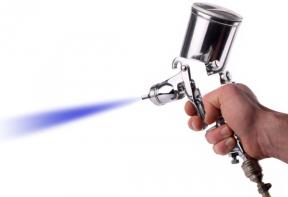Paint sprayers for an easy finish
Power painters make short work of finishing
Traditional painting tools such as brushes and rollers can handle just about every DIY painting job there is, including finishing furniture. There may come a project, however, that persuades you to step up to a power-painting system. Such power-painting tools were, only a short time ago, considered the preserve of professionals. But there are now dozens of consumer-grade paint-application systems on the market. With a little practice, they can lay down coatings quickly and efficiently, yielding professional-looking results.
The basics
Most of us are familiar with traditional paint sprayers, the type with handheld spray guns that use high-pressure air from a compressor to atomize a finish. As an alternative to this method, airless sprayers mechanically force a finish material under high pressure through a fine tip.
The capacity of a painting system to spray coatings depends on a number of factors. Ratings such as horsepower, gallons per minute and pounds per square inch of pressure are all indicators of how powerful a sprayer is. Another critical factor to note is the manufacturer’s recommendations regarding the coating thickness or viscosity that the machine can spray. Keep in mind that thin coatings, such as stains, require less pressure than paints.
One-piece, motorized, handheld units can be just the right size for smaller jobs, as they hold the finish in a cup attached to the pump. Many sizes are available, so you can get one that will spray the kind of finish you want to apply. Some even come accessorized with a feeder hose to draw paint or stain directly from a can or a backpack, making it possible to take on a larger job.
Larger paint pumps generally draw paint straight from the container, then pump it through a high-pressure hose to a handheld gun. There are three types of pump systems available, depending on manufacturer and model. Diaphragm pumps are generally less expensive to purchase and repair. Piston pumps are powerful and often quieter. Double-stroke piston pumps paint on both the up- and downstroke, offering consistent pressure and powering multiple guns at the same time. Airless paint pumps excel at large exterior jobs, such as house walls, and also painting rough or uneven surfaces. Further, many systems can be accessorized with power rollers that don’t need to be dipped into a paint tray.
Jump to a section
- Page 1 : Paint sprayer basics
- Page 2 : Maintenance and terminology
To leave a comment, please log in












No comments